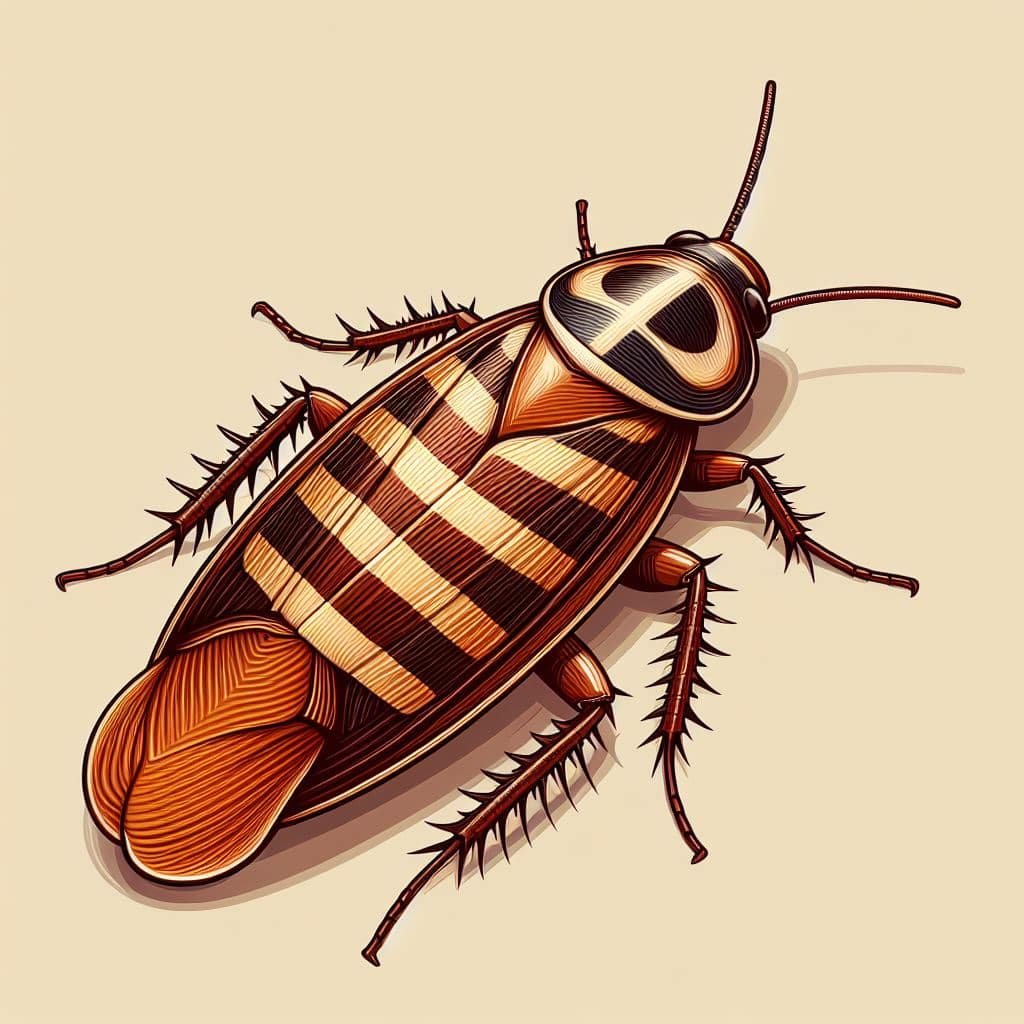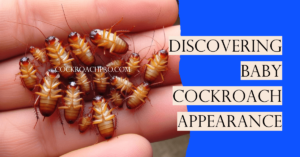The brown banded cockroach is one of the most common household cockroaches found infesting homes across much of the United States.
While they may not carry quite the notoriety of the German cockroach, brown banded cockroaches can be an equally frustrating battle for homeowners who discover these unwelcome insects scurrying across their kitchen counters and cabinets.
Unlike outdoor cockroach species that occasionally find their way inside, the brown banded cockroach has adapted to coexist with humans and thrive within our warm, sheltered indoor spaces. And since each female can produce dozens of offspring every few months, a small brown banded cockroach infestation can quickly grow out of control.
So if those distinctive bands across the cockroach’s wings look all too familiar, read on to better understand these persistent pests and — most importantly — how to kick them out of your house for good.

Brown Banded Cockroach Identification: What Do They Look Like?
The first step in effectively managing any pest is confirming proper identification. The brown banded cockroach earned its name from the two light brown bands stretching horizontally across its wings and body. When fully grown, these cockroaches reach around 1/2 to 5/8 inches (12 to 16 mm) long. Other distinguishing physical features include:
- Oval-shaped body that’s somewhat flattened top to bottom
- Two long antennae
- A reddish-brown color apart from the lighter bands
- Sparsely scattered short hairs covering their body
Compared to German cockroaches, brown banded cockroaches are larger and darker overall, with those unmistakable bands. German cockroaches also move quicker compared to the somewhat sluggish pace of brown banded cockroaches.
However, what the brown bands may lack in speed, they make up for in their ability to reproduce rapidly once settled within your home.
Life Cycle of the Brown Banded Cockroach
Gaining a better understanding of the brown banded cockroach’s life cycle reveals more about why they can inundate homes seemingly overnight.
After mating, an adult female brown banded cockroach carries around an egg capsule, or ootheca, protruding visibly from her abdomen. In this egg case, she can carry up to 18 eggs which hatch after an incubation period of around one to two months.
Once hatched, the nymphs look largely like smaller versions of the adults, albeit without wings. As they grow, the nymphs molt their exoskeletons several times, eventually reaching adulthood after around 60 to 100 days post hatching.
The adults are prolific reproducers, with females producing new egg capsules roughly every 60 days without mating again. As you can imagine, after a year or two just one female brown banded and her offspring can lead to thousands of these unwelcome insects roaming through your home.
How Do Brown Banded Cockroaches Differ From German Cockroaches?
German cockroaches tend to attract more notoriety than brown banded cockroaches, probably because German cockroaches have spread so widely throughout homes, restaurants, and other buildings around the world.
But brown banded cockroaches share many similarities and can reproduce quickly once established indoors.
Some key ways brown banded cockroaches differ from German cockroaches include:
- Size: German cockroaches reach just 1/2 inch (12 mm) in length, making them smaller than brown bands upon maturity.
- Coloration: German cockroaches have a uniformly yellowish-brown appearance, whereas brown banded cockroaches have those darker wing bands.
- Speed: German cockroaches tend to move faster compared to the somewhat slow, lumbering gait of brown banded cockroaches.
- Reproduction Rate: German cockroaches produce more nymphs more quickly compared to brown bands. But both can create substantial populations rapidly.
So while German cockroaches get more notoriety as public health pests, brown banded cockroaches shouldn’t be overlooked or underestimated. Their gradual reproductive pace simply means homeowners may suddenly find themselves overrun by these band winged bugs.
Why Are Brown Banded Cockroaches in My House?
Unlike some cockroach species well adapted to living outdoors, the brown banded cockroach has transitioned over time to thrive within human dwellings.
Originally an African species, these cockroaches likely found their way to the Americas on slave trade ships several centuries ago. They spread out across tropical regions before ultimately adapting their behavior and reproductive cycle to live alongside humans.
Nowadays, brown banded cockroaches often gain initial access to homes by crawling through openings around doors, windows, utility pipes, or exterior vents and drains. Once inside your residence, they orient themselves to areas with ample food and water as well as warmth and humidity that facilitates their breeding.
In particular, brown banded cockroaches seem attracted to starchy materials. So kitchen and bathroom environments provide ideal all-in-one habitat for food, water and moisture.
Clutter like storage boxes, stacks of paper, and cardboard are also breeding hot spots. From these kinds of centralized locations, their populations fan out to more openly visible areas once they reach large numbers.
Getting Rid of Brown Banded Cockroaches
Now that you know what brown banded cockroaches look like, how rapidly they reproduce, and why they’ve set up shop inside your home, it’s time to evict these unseemly squatters.
An integrated pest management (IPM) approach provides the most effective way to eliminate current cockroach infestations while preventing future ones. IPM relies on multiple control tactics including:
- Inspection and Monitoring
- Clutter Reduction
- Cockroach Baits and Traps
- Targeted Insecticide Sprays
Let’s explore each element of an IPM plan specifically tailored for brown banded cockroaches.
1. Inspection and Monitoring
The first step focuses on locating current or potential cockroach harborages through thorough inspection. Check along baseboards and corners, underneath and behind appliances, within cabinets and shelving, around plumbing fixtures, and anywhere else warmer with access to food and moisture.
Use sticky traps or monitoring bait stations to pinpoint areas of highest activity. Focus most intensive treatment efforts on these centralized hot spots first.
2. Reduce Clutter and Access to Food & Water
Starving brown banded cockroaches helps drastically reduce their ability to thrive and breed. Eliminate accessible food by storing all human and pet food in sealed containers and regularly cleaning up any crumbs or residue.
Fix any leaking pipes or drain lines and wipe up excess moisture frequently. Get rid of unnecessary clutter throughout the home including stacks of paper, storage boxes, etc which encourage breeding.
3. Baits and Traps
High-quality cockroach bait combined with trapping provides two routes of attack. Place bait stations along baseboards and next to appliances, under sinks, etc concentrating on areas of observed cockroach activity.
The bait either kills cockroaches directly or contaminates their bodies so they die back at nesting sites. Traps grab wandering cockroaches to immediately reduce numbers. Focus most heavily on confirmed infestation hot spots then expand trapping radially outward to eventually cover the full premises.
4. Contact and Residual Sprays
While baits and traps do most of the elimination work, certain spray insecticides help force cockroaches out of protected hiding spots. Apply contact sprays directly into cracks, crevices, and concealed harborages where traps can’t reach.
Residual sprays create a chemical barrier on open surfaces to kill roaming cockroaches traversing through treated areas. Use these sprays conservatively along with IPM to avoid scattering cockroaches deeper into inaccessible areas.
5. Bringing in Professionals as Needed
For heavy infestations beyond the scope of DIY treatment, work with a licensed pest control company. Professionals have access to more advanced insecticides and precision equipment for accessing confined treatment areas. They also know the most effective application methods for targeting serious brown banded cockroach issues specifically.
6. Stay Vigilant!
Completely eliminating an existing brown banded cockroach infestation and keeping them away long term requires diligence. Continuously monitor for signs of rebounding activity after initial knockdown and maintain a lower level of traps or bait stations.
Fix any newfound entry points cockroaches could use to sneak back in. By taking an informed, strategic approach tailored specifically to brown banded cockroach behavior and biology, you can reclaim a pest-free home environment.
Conclusion
With their quick reproduction cycle and tendency to rapidly expand populations, brown banded cockroaches can be intensely frustrating invaders once established inside.
But through integrated pest management including sanitation and clutter reduction paired with targeted insecticides, homeowners can decimate current infestations and guard against future ones. Taking the time to seal up entry points and maintain diligent monitoring also pays dividends for keeping these persistent pests at bay for good.
So don’t surrender your kitchen or bathrooms just yet. With the right weapons at the ready, the brown banded cockroach finally meets its match.




